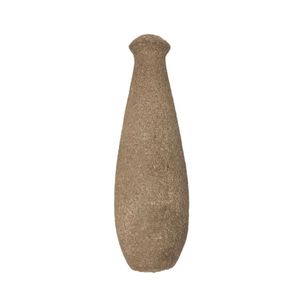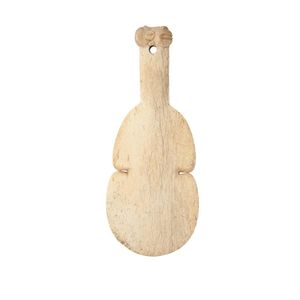Masterfully Carved Whalebone Kotiate Weapon
You must be a subscriber, and be logged in to view price and dealer details.
Subscribe Now to view actual auction price for this item
When you subscribe, you have the option of setting the currency in which to display prices to $Au, $US, $NZ or Stg.
- Patination / Patina - In broad terms, patination refers to the exterior surface appearance of the timber, the effect of fading caused by exposure to sunlight and air over the course of a century or more, changing the piece to a soft, mellow colour.
As patina is very difficult to replicate, it is one of the most important guides to determining the age of furniture.
Patina is also the term applied to the bloom or film found on old bronzes due to oxidisation. - Kauri - An evergreen conifer tree associated with New Zealand, but also grown in northern Australia, and islands around the Pacific rim including Borneo, Vanuatu and New Guinea. The timber is generally golden in colour, and straight grained without much knotting.
A by-product of the kauri tree was the kauri gum, the fossilised resin extracted from the tree. The gum was obtained through digging, fossicking in treetops, or more drastically, by bleeding live trees. Kauri gum was used in the manufacture of varnishes and other resin-based products, and also crafted into jewellery, keepsakes, and small decorative items.
Kauri forests were prolific in the north of the North Island of New Zealand. European settlers in the 1700 and 1800s realised that the timber from these tall trees with broad trunks would be ideal for ship building and construction and a thriving industry was established harvesting the kauri tree. The forests were substantially reduced, and now the remaining Kauri trees that grow in New Zealand are protected, and there are reserves in various areas of the North Island.
The remaining stands of kauri in New Zealand are under threat from "kauri disease", a microscopic organism that causes dieback in the trees, with vast tracts either dead or dying.
This item has been included into following indexes:
- Maori artefacts
Visually similar items

Whalebone kotiate. Carved whalebone in a traditional form with a symmetrical blade, manaia head with open mouth and protruding tongue to handle end. Length 29.2 cm. Width 14 cm

A superb early 19th century bone club (kotiate). bi-lobed shape with carved head to handle, hourglass hole. Length 31 cm

A superb early 19th century whalebone hand club (kotiate), with engraved human head to butt. Red wax in one of the eyes. Excellent patina. Length 31.5 cm. Width 16 cm

Patu muka, stone pounder of classic form and large proportions. Ovoid cross section and body tapering to a flared rounded end. Length 37 cm. Width 10.5 cm
